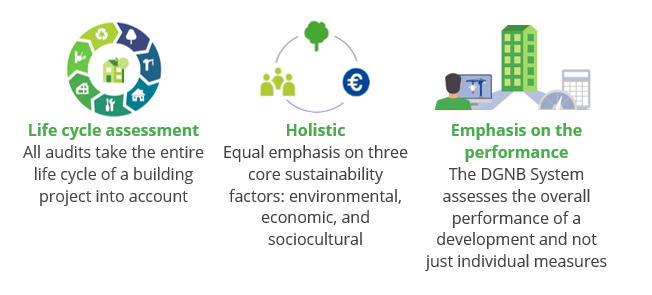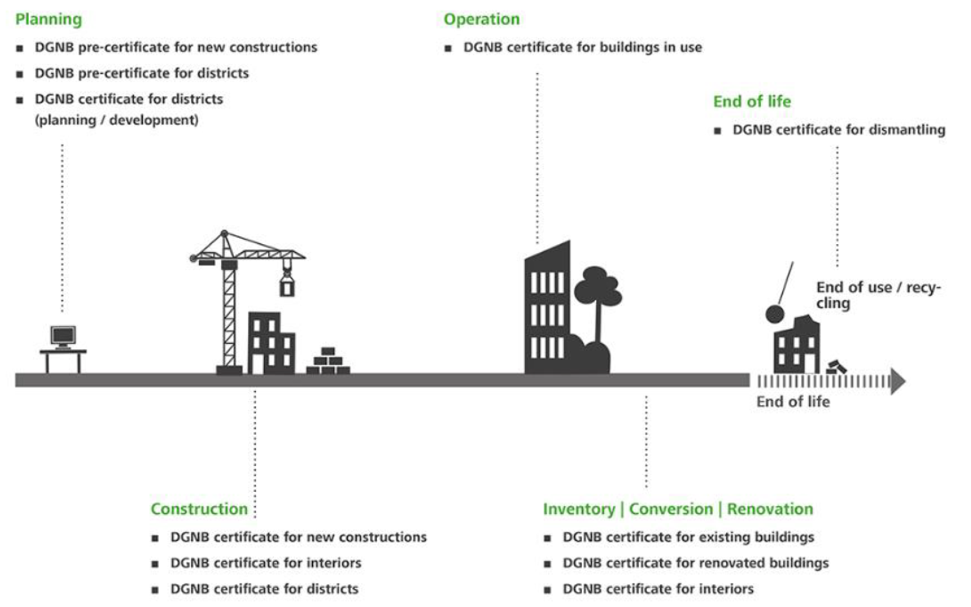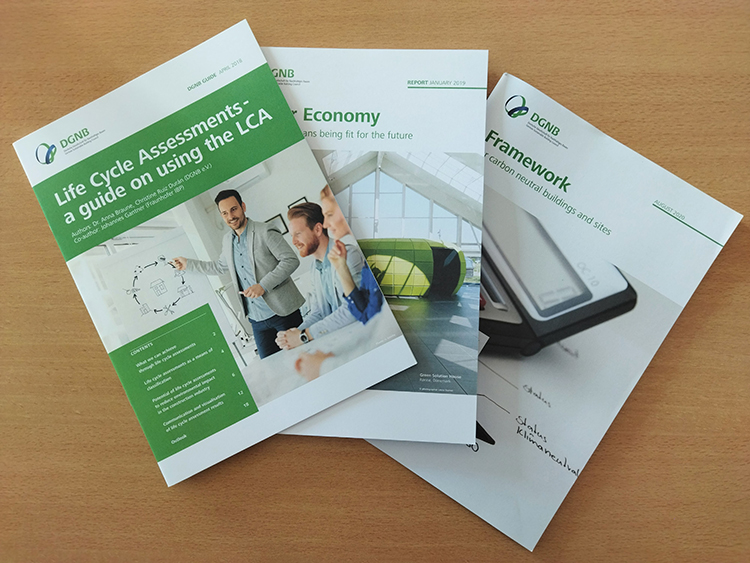The DGNB Certification System: A Unique Approach to Sustainability
The DGNB System is a sustainability assessment system for the built environment, serving also as a tool for planning, designing, constructing, and operating built environments in a sustainable manner.
Developed in year 2009 by the German Sustainable Building Council (DGNB System is named after its German name “Deutsche Gesellschaft für Nachhaltiges Bauen”), the DGNB System has become a global benchmark for the sustainability due to its holistic approach and alignment with the regulatory framework of the European Union. It has proven to be an optimal tool for evaluating and optimizing the sustainability of buildings and urban areas.
The DGNB System provides a set of criterion catalogues and indicators with defined threshold values and verification methods. These tools can demonstrate the sustainability of a building, urban area (district), or interior, while also assisting investors, designers, and users of the built environment in planning, constructing, and operating it in a sustainable manner.
The DNA of DGNB System

4 main criteria catalogues the built environment in DGNB System

Since its establishment, the Green Building Council Croatia has been informing the professional community about the elements of sustainability. However, there is also a need to objectively quantify and valorise sustainability as a characteristic of the built environment through one of the internationally recognized systems and tools.
After a comparative analysis of the three most significant sustainability assessment systems, it was concluded that the DGNB System is the most suitable for the Croatian market due to the following reasons:
- It is the only system that originated in the European Union and is therefore adapted to the European regulatory framework.
- It is the only system that gives equal weight to each of the three ESG sustainability principles (environment, economy, and social) in the overall performance assessment.
For this reason, the Green Building Council Croatia became the national partner of the DGNB System for Croatia in October 2021.
The evaluation process takes into account the entire building lifecycle, from the planning and design phase, through construction, the operational phase (building use phase), to the end of the building’s life cycle (demolition).
Based on predefined criteria and target values, buildings can attain different classifications. The efficiency index determines whether a building earns a platinum, gold, silver, or bronze certificate.
Local consultants, well-versed in the DGNB certification system and the specific regional conditions, propose tailored optimizations for local implementation. These optimization proposals are subsequently subject to approval by DGNB.
Are you interested in certifying a project, building, neighborhood, or interiors according to comprehensive European sustainability principles?
Register your project here:
Since 2016, the Green Building Council Croatia has proudly held the designation of DGNB Academy Partner. This status empowers us to address the specific requirements and educate local experts in the field of the built environment, equipping them with the knowledge and criteria necessary to attain DGNB certification.
Currently, there are 30 certified DGNB consultants actively operating in Croatia. You can find the complete list here:


Example of a Project with a DGNB Platinum Pre-Certificate: Neubau Bürogebäude, 3.BA Vector Regensburg, RB01; Vector Informatik GmbH
Pilot Phase in Progress
During the pilot phase of adapting the DGNB system to the Croatian market, all clients, registered projects, and consultants stand to benefit. The inaugural DGNB certificate will be conferred upon the Matrix C office building in Zagreb.
If you aspire for your project to champion a sustainable and environmentally friendly future, seek out a Croatian consultant who can expertly guide you through the process. The DGNB certificate provides investors with market-recognized quality assurance, particularly significant in the current era of climate challenges. Users of these spaces also appreciate the significance of occupying environments that positively impact health, overall well-being, and the environment.
The pilot phase is well underway, and we invite you to join us as advocates for sustainable change!
DGNB Academy: Building Expertise
Since 2016, the Green Building Council Croatia has proudly held the title of DGNB Academy Partner. This distinction empowers us to address the specific needs of our local experts in the built environment, offering comprehensive education about the criteria and evaluation processes required to attain the coveted DGNB certificate.
Discover more about the education and training opportunities available for DGNB Registered Professionals and DGNB Consultants here
DGNB brochures

All DGNB publications can be downloaded directly from DGNB web page free of charge in PDF format. All you need to do is log in with your DGNB User Account. In addition, you can order a printed copy of selected publications free of charge from the DGNB.
DGNB brochures can be read online:
EU Taxonomy Study: Climate change mitigation
The property market has quite a bit of catching up to do if it wants to work through the taxonomy criteria laid down by the European Union. This is partially because stakeholders lack the information they need to fulfil verification requirements. In addition, the way some of the criteria are currently formulated, they are practically impossible to fulfil. This is the conclusion of a recent study conducted by the DGNB in collaboration with partners from Denmark, Austria and Spain. It also includes concrete recommendations to the EU Commission and market stakeholders aimed at making it easier to apply the criteria in the future.
Life Cycle Assessment – a guide on using the LCA
These guidelines aim to promote the increased use of life cycle assessments in the planning process, by demonstrating the relevance and potential of this tool. Designers and building contractors are additionally provided with arguments for employing these methods as an optimisation tool as early as possible in the planning and implementation process, and the sustainability effects that can be achieved as a result of this are emphasised. Furthermore, the reader is presented with examples of how the results of life cycle assessments are communicated and can serve as supporting arguments for making more environmentally sensible decisions in the course of the planning process.
In recent years the term “circular economy” has become more widespread and has also become a relevant topic in construction. The concept upon which the circular economy is based has great potential: The availability of resources should be ensured for future generations through their appreciation, as well as reuse and recovery. The circular economy is therefore an elementary building block of sustainability and it transfers sustainability to society and its individual sectors.
Framework for carbon neutral buildings and sites
In the Framework, the DGNB has compiled its definition of carbon neutrality as well as the corresponding explanations regarding procedures. The aim is to create clarity on the market and to educate all stakeholders with regard to effective optimisation approaches for reducing the CO2 emissions of their properties. Among other things, the Framework describes the rules for CO2 accounting of buildings and sites. It also serves as a basis for developing building-specific climate action strategies. Additionally, requirements and possibilities for CO2 reporting and quality assurance are presented.
